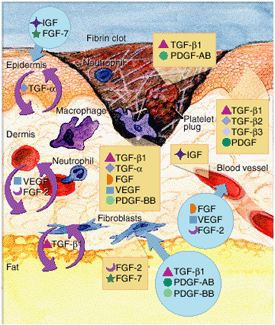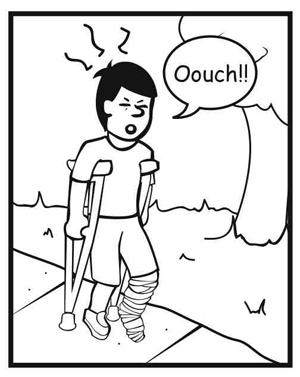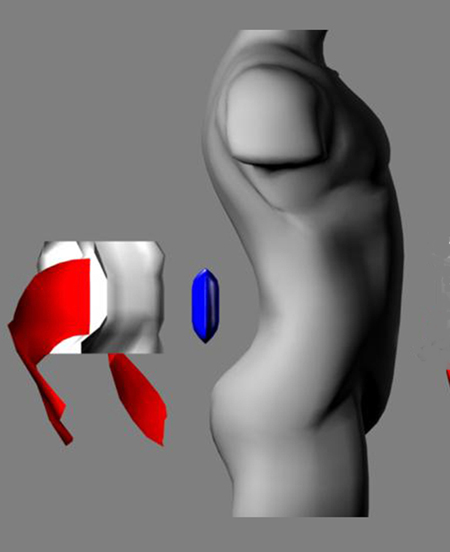One primary foundation of medicine is to intervene into an injury and remove the conditions that caused the wound. We recommend the therapeutic laser is ideal in treating many wounds.
A sports injury goes through a process. The impact causes cell death. These cells deteriorate into noxious chemicals. These noxious chemicals must be exhausted within the body, is another mechanism and that is that the vessels close down to reduce the loss of body fluids. This is a survival mechanism. But, this mechanism also has an effect to the body’s ability to evacuate edema.
If noxious chemicals build up inside the cell, pH of the cell is dramatically altered causing osmotic pressure, and the cell wall explodes, spewing the residue into adjacent cells

Most sports injuries involve the rupture of tiny blood vessels or capillaries. Coagulation occurs within one to three minutes. The bleeding is stopped. This is one step in restoring homeostasis, however the microscopic process can continue: when the injured tissue is moved, the ruptures re-occur. Bleeding resumes, additional cells are injured, which spew noxious chemicals around the injuries that must be evacuated by the lymphatic system.
To illustrate these noxious chemicals, consider that 98% of potassium-iron is contained inside the cell wall. When the cells are injured, potassium a constant irritant to adjacent cells and needs to be evacuated via lymphatic vessels.
Another barrier in establishing homeostasis is that the lymphatic vessels have been constricted due to the autonomic nervous system. Since the lymphatic vessels are constricted they cannot work effectively to sort the noxious chemicals and drained them from the injury site.

Two areas exist for every injury
1) The site where damaged cells have been injured.
2) The site where the inflammation exists (pool of damaged cells have died).
These sites commonly overlap although they are not necessarily the same shape.
Vicious Cycle
These are often in the same location when each one must be acted at once to start healing.
When an injury exists, every time you move you rupture tiny blood vessels in the injury. This releases more noxious chemicals that stimulate the “C” fibers. These chemical cause more pain. Pain causes an autonomic response to constrict smooth muscles to prevent the loss of body fluid but this also traps edema.
It is necessary to use the laser that creates endorphins that cause the smooth muscles (involuntary) to dilate allowing edema to be evacuated via the lymphatic vessels
The cycle of injuries
To understand the wong way medical method you should consider the fundamental mechanisms of injury:
Note
Swelling is pressure from the accumulation of noxious chemicals are
result from tissue that dies from an injury.
1) Human cells are highly enriched substances consisting of numerous metals and chemicals.
2) Even when these elements exist in liquid form, once cells die from an injury, these nutrients turn into a pool of noxious chemicals almost like a pool of industrial waste,
3) The body has a system to evacuate these chemicals through a tiny network of vessels called the lymphatic system,
4) Another mechanism (triggered by pain) is designed to cause vessels to constrict to protect from the loss of precious body fluids (such as blood). This is part of the autonomic nervous system. The diameter of these vessels is controlled by the body. When an injury is present the tiny smooth muscles constrict and squeeze the vessels to limit the size.
5) Also, clotting is a critical mechanism associated with injuries because clotting is the first step in limiting the loss of bodily fluid.
These factors effect healing
Now with this knowledge, considered these factors that influence the process of healing:
a) If an injured site continues to have mechanical motion, but blood cannot clot.
b) If cells continue to be destroyed leaving a residue of noxious chemicals continue to spew into a constant pool.
c) The Lymphatic system is closed (near an injury site) when the blood vessels are closed.
d) Before healing can occur, the cellular waste must be exhausted.

Stop the motion and let it heal!
So the effects of these factors need to be addressed:
1) Where motion continues around an injury site, the speed of healing is reduced.
2) Even if the pain to the brain is blocked, the stimulus still exists to place these tiny smooth muscles in spasm and continues to constrict the lymphic vessels.
To achieve healing at a site,
- The injured site must be located. Often this injury is at a DIFFERENT location than where the pain resides.
- The injured site must be treated so the Lymphatic system can be opened up and drain the pool of residual chemicals from the injury.
- Motion at the injured site must be restricted so further cell damage does NOT occur.
- Muscles do not grow back once injured. Muscle tissue is replaced by what is commonly referred to as scar tissue which is really collagen that acts as an epoxy to bind muscle tissues back together.
How can a cut heal if you do not let it?
If you had any doubts that tissue immobilization is a key factor in the healing process consider this absurd test (Do not really do this)! If you were to cut your forearm with a sharp clean knife about 1 inch in length, it would immediately begin to bleed. If every 10 minutes, you pulled the cut apart and separated the tissue - exposing the injured tissue - it would continue to bleed and would not clot at the center. If you continue this for a day or two, you develop inflammation and possibly an infection. The test results should establish that, injured tissue when mechanically stimulated, is further harmed. Immobilization is required to initiate the healing process on any favorable terms.
Now, change the test around. Instead of separating the cut tissue, immediately treat the wound with an antiseptic and bind it with some device to protect and immobilize the injured tissue, healing would occur.
Almost all tissue: skin, bone and soft tissue – all follow the same healing process. To summarize, the process is to identify the injury, treat the injury and immobilize the injury.

Simple injuries can become chronic pain
Proper diagnosis of the cause of an injury is fundamental to treatment. This should be obvious but often simple injuries are not diagnosed correctly. When simple injuries do not heal they can lead to chronic pain. Most simple injures that lead to chronic pain are results on one or more of the following:
1) Ignore the true source of the injury.
2) Treat the wrong spot. Many theories say treat the trigger point when in fact if you do some reading the trigger point is not identified as the true source of the injury it is just identified as a location along the injury.
3) Stretch the torn tissue. much advice is given that tissue does not heal together should be stretched immediately after the injury
If you are "well" you cannot get "weller". If you take a pill and the symptoms are not present (for its prescription) in many cases the human body is designed to not use what it does not need.
Consider the treatment process. The cell that needs the infrared energy absorb it. the cells that do not, dissipates the energy as heat.
Soft tissue injuries are the most commonly sustained pathology that occurs during sporting, recreational and activities of daily living.
There are three phases of soft tissue healing:
- inflammation,
- proliferation and
- remodeling.
During the inflammatory phase of healing, the physiological rational of treatment is to prevent prolonged inflammation, promote collagen and ground substance synthesis, and prevent disruption of newly forming blood vessels and collagen fibrils.
During the proliferate and remodeling stages of healing, intervention should be directed at reestablishing neuro-musculoskeletal parameters, and restoring the physiological and mechanical properties of the tissue.

